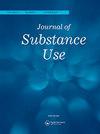物质使用障碍的依恋类型、情绪调节困难与正念
IF 0.6
4区 医学
Q4 SUBSTANCE ABUSE
引用次数: 0
摘要
摘要目的研究物质使用障碍(SUD)患者的依恋、情绪调节和正念,并与对照组(CG)进行比较。方法选取50例SUD患者和50例正常人作为研究对象。患者组采用成瘾特征指数(API),两组采用社会人口学数据表、正念注意意识量表(MAAS)、亲密关系体验量表(ECRS)、情绪调节困难量表(DERS)和SCID-5。结果两组患者年龄、文化程度、MAAS、ECRS、DERS评分差异有统计学意义。logistic回归分析显示,药物使用与年龄、受教育程度、逃避型依恋(ECRS)和DERS存在显著性差异。年龄、受教育程度和MAAS表现出保护作用,而ECRS(回避依恋)和DERS表现出弱预测作用。MAAS呈负向显著,保护作用弱,并确定ECRS(焦虑依恋)和DERS对SUD严重程度具有正显著和中度预测作用。结论依恋障碍和情绪失调对SUD和严重程度的影响可能更明显,而正念对SUD和严重程度的影响可能更弱,对这些变量的评价可能具有重要的预防和治疗意义。关键词:物质使用障碍意识依恋情绪调节披露声明作者未报告潜在的利益冲突。本研究没有外部支持。本文章由计算机程序翻译,如有差异,请以英文原文为准。
Attachment styles, emotion regulation difficulties and mindfulness in substance use disorder
ABSTRACTObjective This study aimed to evaluate attachment, emotion regulation, and mindfulness in patients with substance use disorder (SUD) in comparison to a control group (CG).Methods The study comprised 50 individuals with SUD and 50 healthy people. Addiction Profile Index (API) was applied to the patient group whereas a sociodemographic data form, Mindful Attention Awareness Scale (MAAS), Experiences in Close Relationships Scale (ECRS), Difficulty in Emotion Regulation Scale (DERS) and SCID-5 were applied to both groups.Results Age, education level, MAAS, ECRS, DERS scores showed statistically significant differences between the groups. Substance use and age, education level, ECRS (avoidant attachment) and DERS were shown to be significant in logistic regression analyses. Age, education level and MAAS demonstrated protective effects, while ECRS (avoidant attachment) and DERS showed weak predictors. MAAS was found to be negatively significant with a weak protective effect and determined that ECRS (anxious attachment) and DERS were positively significant and moderately predictive in the SUD severity.Conclusion It can be concluded that disordered attachment and emotion dysregulation may have a more pronounced effect on SUD and severity, while mindfulness may have a weaker efficacy with the evaluation of these variables, which may be important in terms of prevention and treatment.KEYWORDS: Substance use disordermindfulnessattachmentemotion regulation Disclosure statementNo potential conflict of interest was reported by the author(s).Additional informationFundingThere was no external support for this study.
求助全文
通过发布文献求助,成功后即可免费获取论文全文。
去求助
来源期刊

Journal of Substance Use
SUBSTANCE ABUSE-
CiteScore
1.60
自引率
0.00%
发文量
129
期刊介绍:
Journal of Substance Use is a bimonthly international journal, publishing peer-reviewed, up-to-the-minute articles on a wide spectrum of issues relating to the use of legal and illegal substances. The Journal aims to educate, inform, update and act as a forum for standard setting for health and social care professionals working with individuals and families with substance use problems. It also informs and supports those undertaking research in substance use, developing substance use services, and participating in, leading and developing education and training programmes.
 求助内容:
求助内容: 应助结果提醒方式:
应助结果提醒方式:


